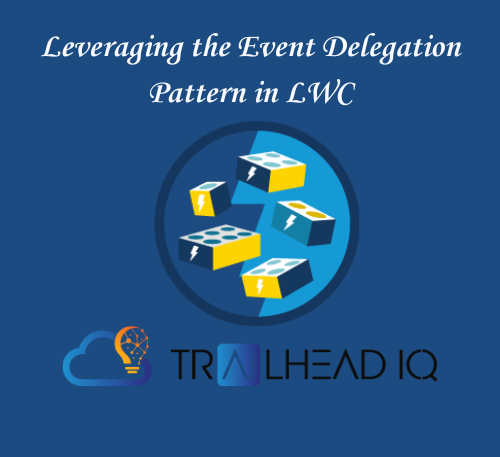What is Event Delegation?
Event delegation is a pattern in JavaScript where a single event listener is added to a parent element to manage events for its child elements. Instead of adding event listeners to each individual child element, event delegation takes advantage of event bubbling. Event bubbling allows the parent element to handle events for its descendants by listening to events as they “bubble” up through the DOM.Why Use Event Delegation in LWC?
In Lightning Web Components (LWC), event delegation can simplify code, improve performance, and reduce memory consumption by minimizing the number of event listeners. This is particularly useful in dynamic UIs where elements are frequently added and removed.Benefits of Event Delegation
- Simplified Code: Manage events for multiple child elements with a single event listener.
- Performance: Reduce the number of event listeners, leading to better performance.
- Maintainability: Easier to manage and update event handling logic in one place.
Example in LWC
Imagine you have a list of items, and you want to handle click events for each item. Using event delegation, you can achieve this with a single event listener on the parent element. In this example, clicking any item will trigger thehandleItemClick method on the parent element (item-list), and the item’s ID will be logged to the console.
HTML
<!-- eventDelegation.html -->
<template>
<lightning-card title="Event Delegation Example">
<div class="item-list" onclick={handleItemClick}>
<template for:each={items} for:item="item">
<div key={item.id} data-id={item.id} class="item slds-box slds-theme_shade slds-theme_alert">
<span>{item.name}</span>
</div>
</template>
</div>
</lightning-card>
</template>
JavaScript
// eventDelegation.js
import { LightningElement, track } from 'lwc';
export default class EventDelegation extends LightningElement {
@track items = [
{ id: 1, name: 'Item 1' },
{ id: 2, name: 'Item 2' },
{ id: 3, name: 'Item 3' }
];
handleItemClick(event) {
const itemId = event.target.dataset.id;
if (itemId) {
console.log(`Item with ID ${itemId} clicked`);
}
}
}
Detailed Explanation
- Template Structure:
- The HTML template includes a
lightning-cardcomponent that contains adivwith the classitem-list. Thisdivacts as the parent element to which the event listener is attached. - Inside this
div, atemplateloop (for:each) iterates over theitemsarray, creating adivfor each item with itsdata-idattribute set to the item’s ID.
- The HTML template includes a
- JavaScript Logic:
- The
itemsarray is defined using the@trackdecorator to make it reactive. - The
handleItemClickmethod is called whenever a click event occurs on any of the child elements insideitem-list. - The
event.target.dataset.idretrieves thedata-idof the clicked element, and if it exists, logs the item’s ID to the console.
- The
Advantages of Using Event Delegation
- Reduced Event Listeners: By using a single event listener on the parent, you avoid the overhead of attaching multiple listeners.
- Dynamic Content Handling: Event delegation makes it easier to handle events for dynamically added or removed elements, as the parent listener can handle them without needing to reattach listeners.
- Cleaner Code: Centralizing the event handling logic in one place simplifies the code and makes it easier to maintain.
Conclusion
Harnessing the power of event delegation can lead to more efficient and maintainable Lightning Web Components. By reducing the number of event listeners and centralizing the event handling logic, you can create performant and scalable components in your Salesforce applications.Additional Tips
- Event Propagation: Understand the difference between event bubbling and event capturing to fully leverage event delegation.
- Delegation Targets: Ensure that the parent element used for delegation is appropriately scoped to avoid unwanted event handling.
- Performance Considerations: Although event delegation can improve performance, be mindful of deeply nested structures where event propagation might introduce latency.






